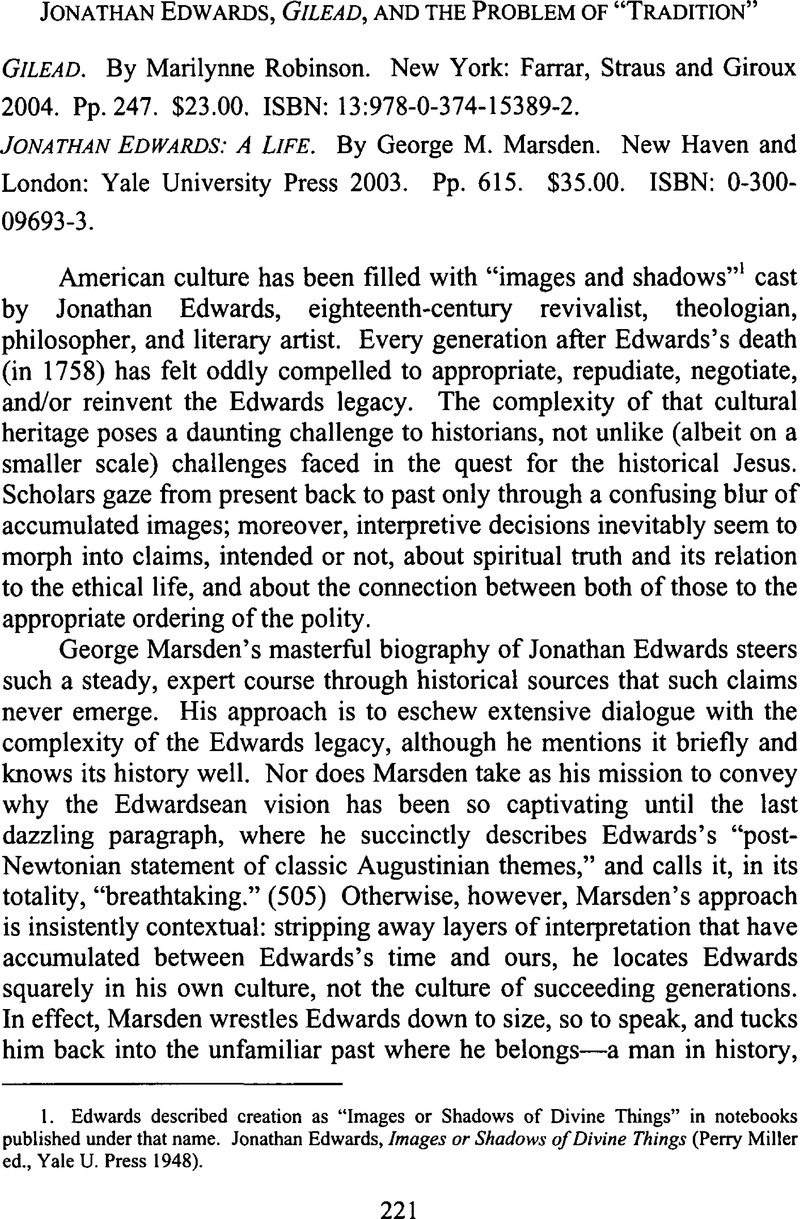Article contents
Jonathan Edwards, Gilead, and the Problem of “Tradition” - Gilead. By Marilynne Robinson. New York: Farrar, Straus and Giroux2004. Pp. 247. $23.00. ISBN: 13:978-0-374-15389-2. - Jonathan Edwards: A Life. By George M. Marsden. New Haven and London: Yale University Press2003. Pp. 615. $35.00. ISBN: 0-300-09693-3.
Published online by Cambridge University Press: 24 April 2015
Abstract

- Type
- Book Reviews
- Information
- Copyright
- Copyright © Center for the Study of Law and Religion at Emory University 2005
References
1. Edwards described creation as “Images or Shadows of Divine Things” in notebooks published under that name. Edwards, Jonathan, Images or Shadows of Divine Things (Miller, Perry ed., Yale U. Press 1948)Google Scholar.
2. Reynolds, David S., John Brown, Abolitionist 25 (Random House 2005)Google Scholar.
3. Quoted in Conforti, Joseph A., Jonathan Edwards, Religious Tradition and American Culture 3 (U.N.C. 1995)Google Scholar.
4. Id. at 194.
5. Shortly after Marsden's biography of Edwards was published another biography appeared, Gura, Philip F., Jonathan Edwards: America's Evangelical (Hill & Wang 2005)Google Scholar. Shorter and more focused on some key points, it is very useful as well.
6. Weber, Donald, The Recovery of Jonathan Edwards, in Jonathan Edwards and the American Experience 50, 57–59 (Hatch, N. & Stout, H. eds., Oxford U. Press 1988)Google Scholar.
7. Marsden, George, The Soul of the American University 82 (Oxford U. Press 1994)Google Scholar.
8. Conforti, supra, n. 3, at 112-115.
9. Marsden, supra n. 7, at 83. Robinson herself described the Lane history in McGuffey and the Abolitionists, in The Death of Adam. Robinson, Marilynne, McGuffey and the Abolitionists, in The Death of Adam 138 (Houghton Mifflin 1998)Google Scholar. Otherwise, it is hard to know how specifically Robinson intends her novel to track the history described here. To some extent it is simply the history of American Calvinism, and Calvin is a subject she has also addressed. See Robinson, Marilynne, Marguerite de Navarre I and II, in The Death of Adam 174–226 (Houghton Mifflin 1988)Google Scholar. Still, the tracking is strikingly close.
10. Conforti, supra n. 3, at 106-107.
11. This history has been described from a variety of perspectives. See, e.g. id., at 108-144; Marsden, supra n. 7, at 103-110; William Breitenbach, Piety and Moralism: Edwards and the New Divinity, in Hatch & Stout, supra n. 6, at 177-204; Bruce Kuklick, Jonathan Edwards and American Philosophy, in Hatch & Stout, supra n. 6, at 246-259; Kuklick, Bruce, Churchmen and Philosophers: From Jonathan Edwards to John Dewey (Yale U. Press 1985)Google Scholar.
12. Conforti, supra n. 3, at 146-147.
13. Id.
14. Id. at 159.
15. The reference is to Perry Miller's, Errand Into the Wilderness; the opening essay describes the frustration of living a “protracted anticlimax” after dramatic “errands” on the model of Christ. Miller, Perry, Errand Into the Wilderness 14 (Belknap Press Harv. U. Press 1956)Google Scholar. Whether Robinson had this in mind is unclear, but the theme of wilderness is recurrent.
16. Perry Miller's oft-criticized but not wholly implausible discussion of From Edwards To Emerson comes to mind. Id. at 184-203.
17. Conforti, supra n. 3, at 148.
18. Id. at 160.
19. Id. at 167.
20. Henry May, Jonathan Edwards and America, in Hatch & Stout, supra n. 6, at 19, 25.
21. Niebuhr, H. Richard, Kingdom of God in America (Clark & Co. 1937)Google Scholar.
22. Id. at 65. May, supra n. 8, at 65.
23. Robinson herself has emphasized the extent to which slavery was built into the British system; it was not specifically “American.” See Robinson, Marilynne, Freed, N.Y. Times Bk. Rev. (01 9, 2005)Google Scholar. She has also written about the British tradition of treating the poor as undeserving and therefore dispensable. Robinson, Marilynne, Mother Country (Farrar, Straus & Giroux 1989)Google Scholar. The notable contrast is to the theological centrality of undeserved (forgiven) love in the Augustinian/Calvinist/Edwardsean “tradition.” (author's reflection).
24. See e.g. Reynolds, supra n. 2, at 19, 24-25. Reynolds points out that abolitionist assumption of racial equality was rare, and occurred almost exclusively among those like Brown's family, who were influenced by Edwards. Brown's father read Edwards right along with the Bible.
25. As with Mary Lyon. See Conforti, supra n. 3, at 100.
26. See Howe, Daniel Walker, Franklin, Edwards, and the Problem of Human Nature, in Benjamin Franklin, Jonathan Edwards, and the Representation of American Culture 75, 88 (Oberg, & Stout, eds., Oxford U. Press 1993)Google Scholar.
27. Edwards, Jonathan, Religious Affections 57–64 (Smith, John E. ed., Yale U. Press 1959)Google Scholar.
28. Gura, supra n. 5.
29. Edwards, supra, n. 26, at 25; for union of “soul and body,” id. at 26.
30. Id. at 25-26, 44-45, 138-139.
31. David Laurence, Jonathan Edwards as a Figure in Literary History, in Hatch & Stout, supra n. 6, at 226, 244.
32. Danaher, William J. Jr., The Trinitarian Ethics of Jonathan Edwards 257 (Westminster John Knox Press 2004)Google Scholar. On social implications see id. at 148-151.
33. Miller, Perry, Jonathan Edwards 191 (Meridian Books 1959)Google Scholar. However inaccurate in not recognizing Edwards's reliance on neo-Platonic philosophers of his time, Miller nevertheless starkly and usefully posed the subject/object dilemma so central to Edwards's thought.
- 1
- Cited by




